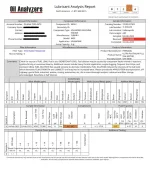Just got my first UOA results back for this car. I’ve been changing the oil every 3000 miles to be safe until I was able to do a UOA. At this point with the fuel dilution I’m thinking I shouldn’t go past 3,000 miles.
2018 WRX 2.0 FADIT - Direct injection
CVT
I am not super familiar with all the other numbers. I was mostly concerned with the fuel dilution. If some doesn’t mind letting me know how every thing else looks I’d appreciate it!
This car is my work commuter. It has never seen a short trip since I’ve had it. It does not idle more 5 minutes a day. I park it in my heated garage, and only let it idle leaving work until it comes off high idle. I set my cruise control at 70-73. Does not see any type of excess acceleration or anything like that. My work commute is 35 miles each way. So 70 miles per day with less than 5 miles of that being non highway.
The interesting thing I’ve noticed is the oil temp very rarely gets over 200 degrees. I’m wondering if the temp not getting over 200 is not allowing the fuel to burn off/evaporate. Not sure what to think about the oil temp.
Thanks in advance guys
2018 WRX 2.0 FADIT - Direct injection
CVT
I am not super familiar with all the other numbers. I was mostly concerned with the fuel dilution. If some doesn’t mind letting me know how every thing else looks I’d appreciate it!
This car is my work commuter. It has never seen a short trip since I’ve had it. It does not idle more 5 minutes a day. I park it in my heated garage, and only let it idle leaving work until it comes off high idle. I set my cruise control at 70-73. Does not see any type of excess acceleration or anything like that. My work commute is 35 miles each way. So 70 miles per day with less than 5 miles of that being non highway.
The interesting thing I’ve noticed is the oil temp very rarely gets over 200 degrees. I’m wondering if the temp not getting over 200 is not allowing the fuel to burn off/evaporate. Not sure what to think about the oil temp.
Thanks in advance guys

